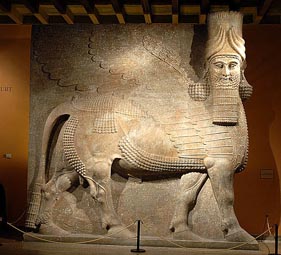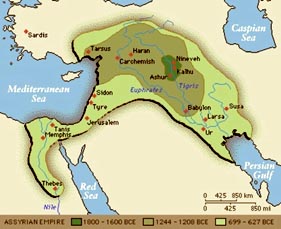

The ancient guardian, Lamassu, has new
meaning as a symbol of Assyrian heritage.

The Assyrian Empire included Mesopotamia,
Egypt, and the eastern Mediterranean region.
ANCIENT EMPIRE
Assyrian civilization dates back to 5000 BC, making it one of the world's first civilizations and oldest surviving cultures.
Accomplishments of ancient Mesopotamia include the invention of glassmaking and the first code of laws. Assyrians carved beautiful relief sculptures from stone. The Lamassu or winged bull is a symbol of Assyrian heritage. In ancient times, these immense scuptures stood in pairs to guard the entrance of the royal palace or city gates.
Assyrians had a great knowledge of astronomy. The precision of their measurements, coupled with the discovery of a 3000-year-old lens, led some to suspect they may have invented the telescope, 2600 years before Galileo! Assyrians represented Saturn as a figure ringed with snakes, but Saturn's rings are not visible to the naked eye.
The site of Nineveh was settled around 5000 BC. By 2500 BC, thriving cities had developed at Nineveh, Assur, and Arbel.
The city state of Ashur (also written Assur) became influential and established trading colonies in what is now Turkey. A rivalry developed between Ashur and its southern neighbor, Babylon. In the 1700s, King Hammurabi of Babylon captured the city of Ashur and added it to his empire. At other times, Assyria was dominant over Babylon. During the period 911 to 612 BC, the Assyrian Empire expanded to include all of Mesopotamia, Ancient Egypt, and the eastern Mediterranean.
Ancient Assyrians believed in One God, who they called "Ashur". The land of "Assyria" was named for Ashur, or perhaps it was the other way around. In either case, Assyrians were among the first to embrace Christianity. The apostle Thomas brought Christianity to Assyria. In 33 AD, he established the Assyrian Church of the East, which survives today as the oldest Christian church.